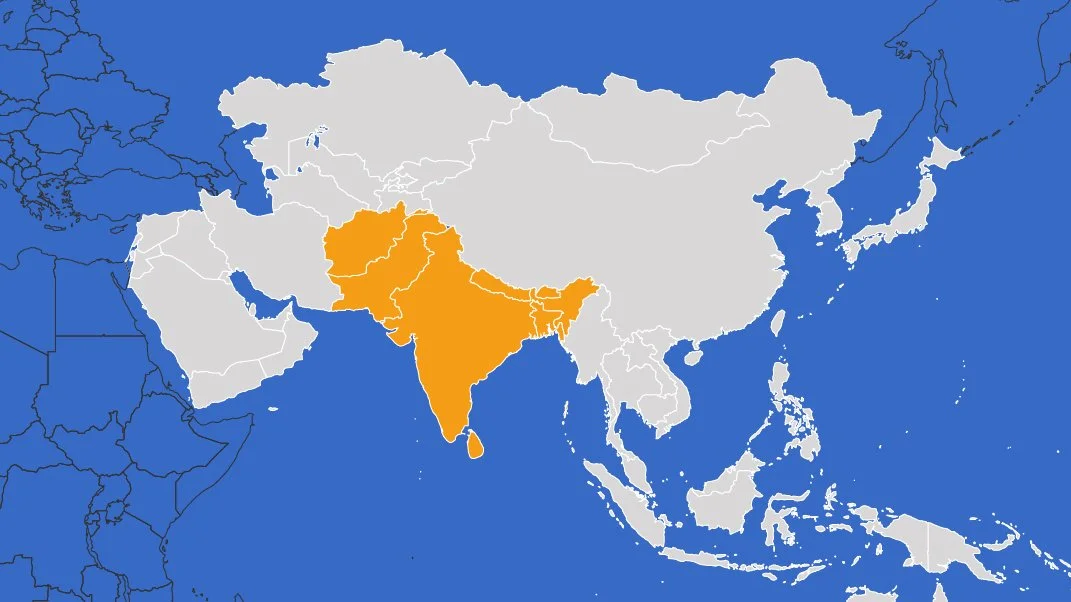South Asia
The countries & regions of South Asia:
Afghanistan | Bangladesh | Bhutan | India | Maldives | Nepal | Pakistan | Sri Lanka
Afghanistan
Afghanistan has a rich history of arts and crafts. The Mesopotamian civilisation had its roots in Afghanistan and they were the first people to use glazed brick as a construction material. As well as its practicalities, it allowed the introduction of colour. These colourful surfaces, decorated with beautiful geometric and floral forms, arabesque panels and elegant bands of calligraphy, eventually became an indispensable element of Islamic architecture, absorbing the creative genius that, in the Christian West, went into frescoes and sculpture.
Bangladesh
Bengal's folk arts and crafts have a continuous tradition, deeply rooted in the pre-Aryan Indo-Gangetic culture, and have evolved by synthesising indigenous elements from various traditions. These include influences from the Brahmaputra-Tibetan-Arakan-Indian Ocean cultural milieu. Ancient Bengal was renowned for its river and sea crafts, including navigation and boat-building techniques, adapted to its many rivers and extensive coastline. Artisans in Bangladesh have preserved these traditions over many generations. Weavers, potters, metalsmiths, wood carvers, and other craftspeople continue to create items for daily use, rituals, and decoration.
Bhutan
In Bhutan, traditional skills and crafts are categorised as zorig chusum, encompassing practices developed over centuries and passed down through families. These crafts, formally categorised during the rule of Tenzin Rabgye (1680-1694), include paper making, stonework, blacksmithing, clay crafts, painting, bronze casting, carving, woodturning, woodwork, weaving, silver and goldsmithing, cane and bamboo work, and embroidery and tailoring. Traditional craftsmanship continues to be passed down, with artisans skilled in various materials, creating functional and decorative items.
India
India has a rich arts and crafts heritage, with each region showcasing unique craft traditions. Ancient texts and archaeological findings reveal a thriving industry of precious goods and skilled artisans. Indian textiles, like Patola silks and decorative cottons, were highly sought after. The decorative arts flourished under royal patronage, particularly the Mughals. Kamaladevi Chattopadhyay, Founder Member of WCC, played a crucial role in reviving crafts. Recent efforts by the Crafts Council of India include conducting surveys directed at methodological issues connected with the craft sector. To support artisans, the Ministry of Textiles offers schemes through the Handicrafts and Handlooms offices, and the Government annually awards the Mastercraftsman’s and Shilpguru Awards to recognise their skills.
Maldives
The Maldives boasts a diverse arts and crafts heritage, with specialization among islands due to materials and traditions. Key crafts include jewellery (gold, silver, pearl, coral), lacquer ware, mat weaving, coir rope, coconut products, textiles, and boat-building. Ribudhoo Island is known for gold jewellery, and Huludeli for silver. Lacquer work is a practiced skilled art, while mat weaving and coconut-based crafts are common. The traditional boat, "dhoni," serves various purposes including transport, fishing, and tourism.
Nepal
Handicraft production in Nepal is an ancient tradition, evolving to meet market demands. The Lichhavi period (450-750 CE) was a golden age for Nepalese art and culture, with advancements in architecture, sculpture, and craftsmanship in stone, wood, metal, and brick. The Licchavi dynasty, the first civilised kingdom, created many exquisite artworks in the Kathmandu Valley. Lalitpur's history begins with the Lichhavi era and Manadeva's 5th-century inscriptions. The Managriha, or House of Mana, mentioned in these inscriptions, is possibly identified with the Mansiggal, later used by the Malla kings, and may have influenced the name of Mangal Bazaar near Durbar Square.
Pakistan
The craft story of Pakistan begins 7000 BC in Mehrgarh, where evolved pottery was discovered. In 3500 BC Indus Valley Civilisation laid the foundations of well-planned cities, brick masonry, and engraved steatite seals in the twin cities of Moenjodaro and Harapa, The arrival of Islam in 712 CE refined the artistic sensibilities resulting in the exquisite calligraphy, geometric and floral patterns found in wood inlay, metal works and the exquisite turquoise blue tile works brought in by the sufi saints. The Mughal built monumental architecture, textiles reached their zenith, Carpet weaving, Lungi weaving, complex Ajrak printing and the intricate Phulkari embroidery. The craft's continuity stands testimony to Pakistan’s rich history, diverse influences, and enduring craft traditions.
Sri Lanka
Sri Lankan crafts embody a rich cultural legacy, reflecting centuries-old traditions, artisanal expertise, and regional diversity. Rooted in the island’s history, these crafts include intricate Dumbara handloom weaving, renowned for its vibrant colors and geometric patterns, as well as mask-making, lacquerware, brassware production, pillow lace, elaborate wood carvings, metalwork, pottery, rush and reed weaving, cane work, Thali Pot craftsmanship, and vibrant batik textiles. Traditional jewellery-making also exemplifies meticulous craftsmanship passed down through generations, with Sri Lanka being especially renowned for its gemstones. Each craft tradition is deeply intertwined with the country’s socio-cultural and religious practices, often drawing inspiration from nature, folklore, traditional motifs, and Buddhist symbolism.
Learn about the countries in other sub-regions
-
West Asia
-
Central Asia
-
South East Asia
-
East Asia
-
South Pacific/Moana Oceania
Meet the people who represent your region
Each region of the WCC-APR is represented by an elected Vice-President, as well as additional Honorary Members and Advisors.

